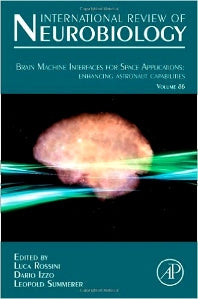Freshly Printed - allow 10 days lead
Couldn't load pickup availability
Brain Machine Interfaces for Space Applications: enhancing astronaut capabilities
Dario Izzo (Edited by), Luca Rossini (Edited by)
9780123748218, Elsevier Science
Hardback, published 10 September 2009
296 pages
22.9 x 15.1 x 2.3 cm, 0.6 kg
Among the most interesting fields in research are the emerging possibilities to interface the human brain directly with machines, e.g. with computers and robotic interfaces. The European Space Agency's Advanced Concept team as a multidisciplinary team from engineering, artificial intelligence, and neural engineering has been working on the cutting edge of exploring brain machine interfaces for application in space as solutions to limitations astronauts face in space, and this book for the first time presents the state-of-the-art-cohesively.
CONTENTS
Contributors......................................................................... xi
Foreword ............................................................................... xv
Preface ................................................................................... xvii
SECTION ONE
HYBRID BIONIC SYSTEMS
EMGBased and GazeTrackingBased Man-Machine Interfaces
Federico Carpi and Danilo De Rossi
I. Introduction ........................................................................ 4
II. EMGBasedInterfaces............................................................. 5
III. GazeTrackingBasedInterfaces.................................................. 12
IV. FinalRemark ....................................................................... 19
References .......................................................................... 19
Bidirectional Interfaces with the Peripheral Nervous System
Silvestro Micera and Xavier Navarro
I. Introduction ........................................................................ 24
II. OrganizationandFunctionofthePNS ........................................ 25
III. Nerve Electrodes:TypesandApplications..................................... 28
IV. Stimulationand RecordingNeuralSignals .................................... 31
V. BiomedicalApplications.......................................................... 33
References .......................................................................... 35
Interfacing Insect Brain for Space Applications
Giovanni Di Pino, Tobias Seidl, Antonella Benvenuto,
Fabrizio Sergi, Domenico Campolo, Dino Accoto,
Paolo Maria Rossini, and Eugenio Guglielmelli
I. Introduction ........................................................................ 40
II. Interfaces............................................................................ 41
III. SensoryandMotorMapping..................................................... 44
IV. ProposingaModelofHybrid Control Architecture ......................... 45
v
vi CONTENTS
V. ConclusionsandOutlook......................................................... 46
References........................................................................... 47
SECTION TWO
MEET THE BRAIN
Meet the Brain: Neurophysiology
John Rothwell
I. Introduction......................................................................... 52
II. HowDoNeuronsTransmit Information?...................................... 53
III. Synapses ............................................................................. 55
IV. TheMotorAreasofthe CerebralCortex....................................... 57
V. PlasticityofPrimaryMotorCortex .............................................. 63
VI. Conclusions ......................................................................... 64
References........................................................................... 65
Fundamentals of Electroencefalography, Magnetoencefalography, and Functional Magnetic Resonance Imaging
Claudio Babiloni, Vittorio Pizzella, Cosimo del Gratta,
Antonio Ferretti, and Gian Luca Romani
I. Introduction to Electroencephalography andMagnetoencephalography ................................................... 68
II. Physiological GenerationofEEG/MEGSignals............................... 69
III. EEG and MEG Techniques Allow the Study of Brain Rhythms............. 73
IV. FunctionalMagneticResonanceImaging ...................................... 74
V. Physiological Generation of Blood Oxygen LevelDependent Signal ...... 75
VI. TypicalfMRIExperimentalDesigns............................................. 77
VII. BOLDfMRITechniquesin Clinical Environment ............................ 77
References........................................................................... 78
Implications of Brain Plasticity to Brain-Machine Interfaces Operation:
A Potential Paradox?
Paolo Maria Rossini
I. Introduction......................................................................... 82
II. BrainPlasticity ...................................................................... 83
III. BrainPlasticityandBMISystems ................................................ 87
IV. MonitoringPlasticityDuringBMIControl ..................................... 88
V. Conclusions ......................................................................... 89
References........................................................................... 89
CONTENTS
SECTION THREE
BRAIN MACHINE INTERFACES, A NEW
BRAINTOENVIRONMENT COMMUNICATION CHANNEL
An Overview of BMIs
Francisco Sepulveda
I. Introduction ........................................................................ 94
II. MainElementsinaBMI.......................................................... 96
III. BMITypes........................................................................... 99
IV. BMIsandtheUser’sAbility...................................................... 102
V. Conclusion.......................................................................... 104
References .......................................................................... 104
Neurofeedback and Brain-Computer Interface: Clinical Applications
Niels Birbaumer, Ander Ramos Murguialday, Cornelia Weber, and Pedro Montoya
I. Introduction ........................................................................ 108
II. FunctionalMagnetic ResonanceImaging: fMRIBMI ........................ 109
III. BMIinLockedinSyndrome..................................................... 110
IV. BMIinStrokeandSpinalCordInjury ......................................... 112
V. Conclusion.......................................................................... 114
References .......................................................................... 115
Flexibility and Practicality: Graz Brain-Computer Interface Approach
Reinhold Scherer, Gernot R. MullerPutz, and Gert Pfurtscheller
I. Introduction ........................................................................ 120
II. GrazBCI ............................................................................ 120
III. Applications......................................................................... 122
IV. Discussion ........................................................................... 127
References .......................................................................... 129
On the Use of Brain-Computer Interfaces Outside Scientific Laboratories: Toward an Application in Domotic Environments
F. Babiloni, F. Cincotti, M. Marciani, S. Salinari, L. Astolfi,
F. Aloise, F. De Vico Fallani, and D. Mattia
I. Introduction ........................................................................ 134
II. Methodology........................................................................ 135
viii CONTENTS
III. Results................................................................................ 142
IV. Discussion ........................................................................... 144
References........................................................................... 146
Brain-Computer Interface Research at the Wadsworth Center:
Developments in Noninvasive Communication and Control
Dean J. Krusienski and Jonathan R. Wolpaw
I. Introduction......................................................................... 147
II. SensorimotorRhythmBasedBCIControl...................................... 149
III. P300BasedBCIControl........................................................... 152
IV. CurrentandFutureDirections................................................... 154
V. Conclusion .......................................................................... 155
References........................................................................... 155
WatchingBrain TV and Playing Brain Ball: ExploringNovel BCI Strategies Using RealTime Analysis of Human Intracranial Data
Karim Jerbi, Samson Freyermuth, Lorella Minotti, Philippe Kahane, Alain Berthoz, and JeanPhilippe Lachaux
I. Introduction......................................................................... 160
II. MaterialsandMethods............................................................ 161
III. Results................................................................................ 161
IV. Discussion ........................................................................... 166
References........................................................................... 167
SECTION FOUR
BRAINMACHINE INTERFACES AND SPACE
Adaptive Changes of Rhythmic EEG Oscillations in Space:
Implications for Brain-Machine Interface Applications
G. Cheron, A. M. Cebolla, M. Petieau, A. Bengoetxea,
E. PalmeroSoler, A. Leroy, and B. Dan
I. Introduction......................................................................... 172
II. SpontaneousEEG Fluctuations:Whereisthe Baseline? ..................... 172
III. Howto Manage AlphaandMu Oscillationsin Space........................ 173
IV. From the Identification Process to the Exploitation ofBrainOscillationsinSpace.................................................... 174
V. The Influence of TopDown Dynamics on BCI Approach ............... 176
VI. Gamma EEG Oscillations: AWindow into Cognition, Perception, Attention, Binding,or MicrosaccadicEye Movements ....................... 179
VII. The Gating of the SomatosensoryEvokedPotentials asaNewToolsforBCI............................................................ 179 References........................................................................... 183
CONTENTS
Validation of Brain-Machine Interfaces During Parabolic Flight
Jose del R. Millan, Pierre W. Ferrez, and Tobias Seidl
I. Introduction ........................................................................ 189
II. Methods............................................................................. 190
III. ExperimentalResults.............................................................. 193
IV. Discussion ........................................................................... 196
References .......................................................................... 197
Matching Brain-Machine Interface Performance to Space Applications
Luca Citi, Oliver Tonet, and Martina Marinelli
I. Introduction ........................................................................ 200
II. Methods: PerformanceMeasuresofHBSs ..................................... 201
III. Materials............................................................................. 202
IV. Results:Matching InterfacesandDevices...................................... 205
V. PossibleDemonstrators ........................................................... 208
VI. Conclusions......................................................................... 209
References .......................................................................... 210
Brain-Machine Interfaces forSpace Applications-Research,Technological
Development, and Opportunities
Leopold Summerer, Dario Izzo, and Luca Rossini
I. Introduction ........................................................................ 214
II. AnOutlookonBMIResearchTrends.......................................... 215
III. Future Manned Space Programs-Planned or Envisioned.................. 217
IV. NextStepsTowardBMIsforSpaceApplications............................. 220
V. Conclusion.......................................................................... 221
References .......................................................................... 221
Index ...................................................................................... 225
Contents of Recent Volumes................................................ 231
Subject Areas: Human-computer interaction [UYZ], Expert systems / knowledge-based systems [UYQE], Artificial intelligence [UYQ], Astronautics [TTDS], Robotics [TJFM1], Neurosciences [PSAN], Biomedical engineering [MQW], Neurology & clinical neurophysiology [MJN]


